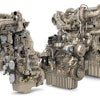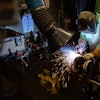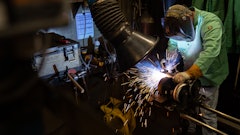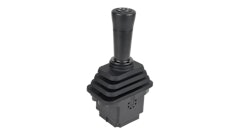HUSCO Intl.'s proprietary distributed hydraulic control system represents a fundamental change in the way fluid power is controlled in mobile equipment, says Les Moore, the firm's marketing analyst. HUSCO introduced its INCOVA (Intelligent Control Valve) technology during ConExpo-Con/Agg's co-located IFPE show in 2005. At the same time, Deere & Co. presented a new loader backhoe equipped with Deere's Total Machine Control (TMC) — which is HUSCO's INCOVA system — installed.
That was three years ago. John Deere's TMC-equipped backhoes have been in full production for more than a year, and the 2008 edition of the giant industry event is here. HUSCO's engineers have been busy between the shows. The Waukesha, WI-based hydraulic control specialist returns to this year's event with new products and a new business unit.
For the 2005 INCOVA introduction at ConExpo, HUSCO brought a telehandler it modified in-house to showcase the capabilities of its new electrohydraulic control system. This year, JLG Industries, McConnellsburg, PA, will unveil its own INCOVA-equipped telehandlers available to the public. Branded by JLG as "Accuplace with Ride Control," the system will be available as an option on the JLG G10-55A and G12-55A telehandlers.
HUSCO's relationship with the telehandler firm started with Omniquip, a company JLG acquired in 2003. JLG began working with HUSCO two years ago.
Hydraulic Wheatstone bridge
The HUSCO INCOVA system uses four independently controlled poppet valves (EHPVs) configured in an H-bridge arrangement, a concept borrowed from electrical engineering. By using pressure sensor feedback and advanced software, INCOVA optimizes valve control while minimizing hydraulic losses.
The technology gives several benefits to equipment manufacturers and operators: efficiency (fuel savings as high as 25%), functionality (coordinating telehandler fork movements or easily changing operating modes), controllability and reliability. By mounting valves near the work functions, the number of hoses, tubes and fittings is reduced. This simplifies work on the assembly line as well as in the maintenance shop.
HUSCO is also marketing the INCOVA system as a Tier 4 strategy for OEMs. It can save fuel and take "a lot of heat out of the traditional hydraulic system," says Andreas Pack, product manager, HUSCO.
Installed on a backhoe, the primary advantages of the system are in productivity and efficiency gains. On a telehandler, INCOVA technology allows for the coordination of boom and fork operation. With one joystick movement the system drives several events on the boom: as the boom is raised it extends, moving the load straight up while keeping the forks level. The JLG Accuplace system allows the telehandler to have X and Y position controls.
"With distributed electronics communicating over a CAN network, the telehandler can travel up a grade and still give a straight stab through a window," says Joe Pfaff, director of INCOVA Programs, HUSCO. "Distributed hydraulics allow the equipment engineer to take counter balance valves off the machine and replace them with distributed poppet valves, improving controllability and efficiency at the same time."
Integrating ride control into the system means the load won't bounce off the forks as the machine travels across rough terrain. When the engine is running, the boom can be lowered with complete control without increasing engine RPM, which is easier on fuel and is less irritating to the operator. In the event the engine quits during a lift, the boom can still be lowered while maintaining a level fork by using the INCOVA system's independent EHPVs to control high pressure oil from the boom to level the forks.
INCOVA's inception has been nicely timed with the industry's tightening emissions regulations and high fuel prices. "INCOVA can help OEMs achieve energy recovery requirements," says Pack.
A good thing better
As the INCOVA system evolves and HUSCO looks into new applications, its engineers are finding the technology is capable of more than what was originally thought. It has also been working to expand its INCOVA product portfolio, including a 24-volt controller for the excavator market.
HUSCO purchased an excavator last year and began retrofitting it with INCOVA. "On that machine the benefits are different from the backhoe and telehandler," says Pfaff. "Today's excavators are fantastic machines to run. They are the smoothest machines available, but they are not particularly efficient. On an excavator, INCOVA's benefits are primarily in improved fuel efficiency. On a standard excavator, nearly all of the engine's energy is going to the hydraulic function."
When swinging, the hydraulic system maintains a significant amount of backpressure for control. "With INCOVA you can maintain good control without the power loss," says Pack. "Until now good control meant you had some losses in efficiency. When fuel was cheap that was OK." Now that fuel is not cheap and Tier 3 and 4 engines need more space for cooling and emissions systems, hydraulic losses are more expensive.
INCOVA technology makes it simpler to recover energy. As the boom is lowered, a high-pressure accumulator stores the energy. When the boom is raised, nearly 35% of the energy used comes from the accumulators. HUSCO has seen savings as high as 10% over an entire dig cycle using the recovery system.
The electronic system makes various options possible at no extra cost to the OEM, but they are features that could be made available for a price to customers. "The software gives the OEM some flexibility for fleet management programs, geographical regions, or different operating styles and patterns," says Pfaff.
For several years the automobile industry has harmonized the control of a car's mechanic systems through the application of sensors and sophisticated electronics.
"We're on the edge of that opportunity with excavators," says Pfaff. "Instead of having independent engine, pump, and valve controls with mechanical or hydraulic interfaces, those elements will start integrating over the CAN network to work together better than ever before.
"INCOVA fits well in the bigger trend toward complete machine integration. The more independence you have in the actuators, the more you will be able to exploit the new system."
Help for, and from, distribution
Just as INCOVA is a new direction for hydraulic control, the SCX-180 valve represents a new business focus for HUSCO.
Over the past 18 months, the company has been giving much attention to its distributor network, an area that HUSCO admits has been historically underserved. Distributor support is now a separate business unit within HUSCO, and distributor-friendly products have been introduced. It recently launched a secure website that features a product configurator that allows distributors to virtually assemble a valve and print a schematic, a bill of material and a price.
The SCX-180 valve started out in a European backhoe application. It was identified as a good platform product so HUSCO engineers worked to develop a range of standard components for it.
"The product is cost effective, flexible, and competitive," says Pack. "There are good products out there. We knew to get into new applications we need a product that drops in easily."
For the OEM that needs something more than an open-center spool valve but is not ready for INCOVA, SCX provides a mid-range option. One of the key features for the compact, post-pressure compensated, closed-center valve is a dedicated section assembly that integrates electrohydraulic (EH) solenoids into the valve body.
"SCX-180 goes with distribution very well," he says. "As a standard product offering it can be ordered and received within two weeks."
While distributors help HUSCO broaden its coverage geographically and in different industries, distributors give the OEM an advantage, as well.
"They are in the manufacturer's backyard, and they know the language of the business done there," says Pack. "They have sophisticated development labs and strong engineering support. They also carry the components HUSCO does not make, providing a complete solution."
As HUSCO's business has grown, its staff has not increased equal to the new business. "Distributors help there, too," says Rick Tortomasi, distribution manager, HUSCO. "What HUSCO makes is one component in a system. The distributor can supply a complete system for the OEM. That is where we have found the value."
Currently, distributor sales are a small percentage of HUSCO's overall business, but Tortomasi sees it growing. Strong growth areas include trash compaction, cranes, utility trucks and mining.
"Distributors give small-to-medium-sized OEMs more local support," says Tortomasi. "They can get there faster than we can with customers all over the world. They also support the OEM with backup inventory and service."
The focus on distribution is changing how HUSCO sees its product line. From the start, HUSCO has typically worked directly with large OEMs to custom-design products for a specific application. The SCX-180 valve represents the first time in years HUSCO has introduced a complete product line.















